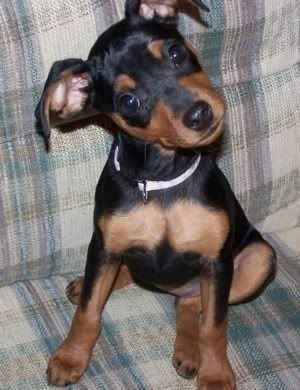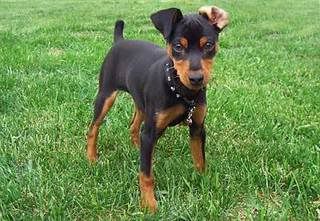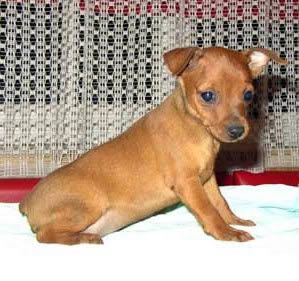Post by charmingnancy on Mar 26, 2009 20:08:44 GMT -5
Miniature Pinscher
Group: 5- Toys
Origin: Germany
Purpose: Ratter
Also Called: Reh Pinscher or "Min Pin"

Description:
This breed is structurally a well-balanced, sturdy, compact, short-coupled, smooth-coated toy dog. He is naturally well groomed, proud, vigorous and alert. The natural characteristics traits which identify him from other toy dogs are his precise Hackney gait, his fearless animation, complete self-possession, and his spirited presence.
Appearance- Breed Standards:
Coat and Colour: Coat smooth, hard and short, straight, and lustrous, closely adhering to and uniformly covering the body. Colour-
a) Solid red or stag red.
b) Lustrous black with sharply defined tan, rust-red markings on cheeks, lips, lower jaw, throat, twin spots above eyes, and chest, lower half of forelegs, inside of hind legs and vent region, lower portion of hocks and feet. Black pencil stripes on toes.
c) Solid brown or chocolate with rust-red yellow markings.
Head: In correct proportion with the body. From top: Tapering, narrow with well-fitted but not too prominent foreface which should balance with the skull. No indication of coarseness. From front: Skull appears flat, tapering forward towards the muzzle. Muzzle itself strong rather than fine and delicate, and in proportion to the head as a whole; cheeks and lips small, taut and closely adherent to each other. Teeth in perfect alignment and apposition. From side: Well balanced with only a slight drop to the muzzle, which should be parallel to the top of the skull. Nose black only (with the exception of chocolates, which may have a self-coloured nose). Eyes full, slightly oval, almost round, clear, bright and dark, even to a true black; set wide apart and fitted well into the sockets. Ears well set and firmly placed, upstanding (when cropped, pointed, and carried erect in balance with the head).
Neck: Proportioned to head and body. Slightly arched, gracefully curved, clean and firm, blending into shoulders, length well balanced, muscular and free from a suggestion of dewlap or throatiness.
Forequarters: Shoulders clean, sloping with moderate angulation, co-coordinated to permit the true action of the Hackney pony. Strong bone development and small clean joints. As viewed from the front straight and upstanding; elbows close to body, well knit, flexible yet strong with perpendicular pasterns.
Body: From top: Compact, slightly wedge-shaped, muscular with well-sprung ribs. From Side: Back level or slightly sloping towards the rear. Length of males equal height at withers. Females may be slightly longer. Fore chest well developed and full, moderately broad. Depth of brisket, the base line of which is level with the points of the elbows; short and strong in loin with belly moderately tucked up to denote grace in structural form. From Rear: High tail-set; strong, sturdy upper shanks, with croup slope at about 30 degrees; vent opening not barreled.
Hindquarters: Well-knit muscular quarters set wide enough apart to fit into a properly balanced body. All adjacent bones should appear well angulated with well-muscled thighs or upper shanks, with clearly well-defined stifles, hocks short, set well apart turning neither in nor out, while at rest should stand perpendicular to the ground and upper shanks, lower shanks and hocks parallel to each other. Feet cat-like, toes strong, well arched and closely knit with deep pads and thick blunt nails.
Tail: Set high, held erect, docked to 1/2 - 1 inch (1-3 cm).
Faults: Structurally lacking in balance, too long or short coupled, too coarse or too refined (lacking in bone development causing poor feet and legs), too large or too small, lethargic, timid or dull, shy or vicious, low in tail placement and poor in action (action not typical of the breed requirements). Knotty overdeveloped muscles. Thin, too long, dull coat; upstanding coat; curly coat; dry coat; area of various thickness or bald spots. Any colour other than listed; very dark or sooty sports. Head too large or too small for the body, too coarse or too refined, pinched and weak in foreface, domed in skull, too flat and lacking in chiseling, giving a vapid expression. Nose any colour other than black (with the exception of chocolates which may have a self-coloured nose). Jaws and teeth overshot or undershot. Eyes too round and full, too large, bulging, too deep-set or set too far apart; or too small, set too close (pig eyes). Light-coloured eyes are not desirable. Ears poorly placed, low-set hanging ears (lacking in cartilage) which detract from head conformation. (Poorly cropped ears if set on the head properly and having sufficient cartilage should not detract from head points, as this would be a man-made fault and automatically would detract from general appearance). Neck too straight or too curved; too thick or too thin; too long or short; knotty muscles; loose, flabby or wrinkled skin on neck. Shoulders too straight, too loose, or too short and overloaded with muscles. Forelegs bowed or crooked, weak pasterns, feet turning in or out, loose elbows. Body from top-too long, too short, too barreled, lacking in body development. Body from side- too long, too short, too thin or lacking depth of chest, too full in loin, sway back, roach back or wry back. Fore chest and spring of rib too narrow (or too shallow and underdeveloped). Body from rear-quarters too wide or too close to each other, overdeveloped, barreled vent, underdeveloped vent, too sloping croup, tail-set low. Hindquarters too narrow, under muscled or over muscle, too steep in croup, too thick or thin bone development, large joints, spreading flat feet. Thin underdeveloped stifles, large or crooked hocks, loose stifle joints. Tail-set too low, too thin, drooping, hanging or poorly docked.
Disqualifications: Thumb marks or any area of white on feet or fore chest exceeding 1/2 inch (1 cm) in its longest dimension. A dog of either sex measuring under 10 in. (25 cm) or over 12.5 in. (32 cm) shall be disqualified.
Size:
Desired height 11 - 11.5 in. (28-29 cm) at the withers. A dog of either sex measuring under 10 in. (25 cm) or over 12.5 in. (32 cm) shall be disqualified.

Temperament:
Min Pin temperament is described in the breed standard as "fearless animation, complete self-possession, and spirited presence." These qualities often lead to problems with unsuspecting first-time owners. The Min Pin is curious, suspicious of strangers, vigorous, curious, inquisitive, funny, fearless, curious, energetic, and curious. He will escape from confinement whenever possible to satisfy his curiosity and indulge his need for activity.
Health:
In spite of its tiny size and fine bones, the Min Pin is a hardy, healthy dog with few genetic problems. He is susceptible to generalized progressive retinal atrophy, an inherited eye abnormality that eventually causes blindness. However, he may suffer from unintentional rough handling of a child and should never be dropped, even from sofa-height, even though he might jump from the same height on his own.
Average Lifespan:
The average life span is 14-17 years.

History:
Despite a great similarity in appearance, the Miniature Pinscher is not, as many believe, descended from the Doberman Pinscher. The breed is, in fact, older than the Doberman Pinscher. It was developed in Germany by crossbreeding various terriers and other dogs, including the German Pinscher, Dachshund and possibly the Italian Greyhound; the Min Pin was originally created to control the rat population in stables.
The Miniature Pinscher – or at least a similar looking dog – was first depicted in paintings and sculptures beginning in the 17th century. It was not documented in writing, however, until some 200 years ago. Many people confuse the relationship between the Miniature Pinscher and the Doberman Pinscher, incorrectly believing that the Min Pin is a miniaturized Doberman. During the 1930s, the Miniature Pinscher breed standard stated that the dog should resemble a small Doberman Pinscher, when in fact the Doberman had been created in 1890 by Lois Dobermann to resemble the Miniature Pinscher. Therefore, it is actually the Doberman that is named and modeled after the Min Pin, not the other way around.
The Miniature Pinscher was first imported to the United States in 1919, and was registered with the American Kennel Club in 1925. Today, the Min Pin is a fixture at dog shows and one of the more popular breeds in the US. It is often referred to as “The King of the Toy Dogs.”
Sources:
Canadian Miniature Pinscher Club (Breed Standard)
Canis Major
Rescue Every Dog
Breeder Retriever
Pictures:
Photobucket
Group: 5- Toys
Origin: Germany
Purpose: Ratter
Also Called: Reh Pinscher or "Min Pin"

Description:
This breed is structurally a well-balanced, sturdy, compact, short-coupled, smooth-coated toy dog. He is naturally well groomed, proud, vigorous and alert. The natural characteristics traits which identify him from other toy dogs are his precise Hackney gait, his fearless animation, complete self-possession, and his spirited presence.
Appearance- Breed Standards:
Coat and Colour: Coat smooth, hard and short, straight, and lustrous, closely adhering to and uniformly covering the body. Colour-
a) Solid red or stag red.
b) Lustrous black with sharply defined tan, rust-red markings on cheeks, lips, lower jaw, throat, twin spots above eyes, and chest, lower half of forelegs, inside of hind legs and vent region, lower portion of hocks and feet. Black pencil stripes on toes.
c) Solid brown or chocolate with rust-red yellow markings.
Head: In correct proportion with the body. From top: Tapering, narrow with well-fitted but not too prominent foreface which should balance with the skull. No indication of coarseness. From front: Skull appears flat, tapering forward towards the muzzle. Muzzle itself strong rather than fine and delicate, and in proportion to the head as a whole; cheeks and lips small, taut and closely adherent to each other. Teeth in perfect alignment and apposition. From side: Well balanced with only a slight drop to the muzzle, which should be parallel to the top of the skull. Nose black only (with the exception of chocolates, which may have a self-coloured nose). Eyes full, slightly oval, almost round, clear, bright and dark, even to a true black; set wide apart and fitted well into the sockets. Ears well set and firmly placed, upstanding (when cropped, pointed, and carried erect in balance with the head).
Neck: Proportioned to head and body. Slightly arched, gracefully curved, clean and firm, blending into shoulders, length well balanced, muscular and free from a suggestion of dewlap or throatiness.
Forequarters: Shoulders clean, sloping with moderate angulation, co-coordinated to permit the true action of the Hackney pony. Strong bone development and small clean joints. As viewed from the front straight and upstanding; elbows close to body, well knit, flexible yet strong with perpendicular pasterns.
Body: From top: Compact, slightly wedge-shaped, muscular with well-sprung ribs. From Side: Back level or slightly sloping towards the rear. Length of males equal height at withers. Females may be slightly longer. Fore chest well developed and full, moderately broad. Depth of brisket, the base line of which is level with the points of the elbows; short and strong in loin with belly moderately tucked up to denote grace in structural form. From Rear: High tail-set; strong, sturdy upper shanks, with croup slope at about 30 degrees; vent opening not barreled.
Hindquarters: Well-knit muscular quarters set wide enough apart to fit into a properly balanced body. All adjacent bones should appear well angulated with well-muscled thighs or upper shanks, with clearly well-defined stifles, hocks short, set well apart turning neither in nor out, while at rest should stand perpendicular to the ground and upper shanks, lower shanks and hocks parallel to each other. Feet cat-like, toes strong, well arched and closely knit with deep pads and thick blunt nails.
Tail: Set high, held erect, docked to 1/2 - 1 inch (1-3 cm).
Faults: Structurally lacking in balance, too long or short coupled, too coarse or too refined (lacking in bone development causing poor feet and legs), too large or too small, lethargic, timid or dull, shy or vicious, low in tail placement and poor in action (action not typical of the breed requirements). Knotty overdeveloped muscles. Thin, too long, dull coat; upstanding coat; curly coat; dry coat; area of various thickness or bald spots. Any colour other than listed; very dark or sooty sports. Head too large or too small for the body, too coarse or too refined, pinched and weak in foreface, domed in skull, too flat and lacking in chiseling, giving a vapid expression. Nose any colour other than black (with the exception of chocolates which may have a self-coloured nose). Jaws and teeth overshot or undershot. Eyes too round and full, too large, bulging, too deep-set or set too far apart; or too small, set too close (pig eyes). Light-coloured eyes are not desirable. Ears poorly placed, low-set hanging ears (lacking in cartilage) which detract from head conformation. (Poorly cropped ears if set on the head properly and having sufficient cartilage should not detract from head points, as this would be a man-made fault and automatically would detract from general appearance). Neck too straight or too curved; too thick or too thin; too long or short; knotty muscles; loose, flabby or wrinkled skin on neck. Shoulders too straight, too loose, or too short and overloaded with muscles. Forelegs bowed or crooked, weak pasterns, feet turning in or out, loose elbows. Body from top-too long, too short, too barreled, lacking in body development. Body from side- too long, too short, too thin or lacking depth of chest, too full in loin, sway back, roach back or wry back. Fore chest and spring of rib too narrow (or too shallow and underdeveloped). Body from rear-quarters too wide or too close to each other, overdeveloped, barreled vent, underdeveloped vent, too sloping croup, tail-set low. Hindquarters too narrow, under muscled or over muscle, too steep in croup, too thick or thin bone development, large joints, spreading flat feet. Thin underdeveloped stifles, large or crooked hocks, loose stifle joints. Tail-set too low, too thin, drooping, hanging or poorly docked.
Disqualifications: Thumb marks or any area of white on feet or fore chest exceeding 1/2 inch (1 cm) in its longest dimension. A dog of either sex measuring under 10 in. (25 cm) or over 12.5 in. (32 cm) shall be disqualified.
Size:
Desired height 11 - 11.5 in. (28-29 cm) at the withers. A dog of either sex measuring under 10 in. (25 cm) or over 12.5 in. (32 cm) shall be disqualified.

Temperament:
Min Pin temperament is described in the breed standard as "fearless animation, complete self-possession, and spirited presence." These qualities often lead to problems with unsuspecting first-time owners. The Min Pin is curious, suspicious of strangers, vigorous, curious, inquisitive, funny, fearless, curious, energetic, and curious. He will escape from confinement whenever possible to satisfy his curiosity and indulge his need for activity.
Health:
In spite of its tiny size and fine bones, the Min Pin is a hardy, healthy dog with few genetic problems. He is susceptible to generalized progressive retinal atrophy, an inherited eye abnormality that eventually causes blindness. However, he may suffer from unintentional rough handling of a child and should never be dropped, even from sofa-height, even though he might jump from the same height on his own.
Average Lifespan:
The average life span is 14-17 years.

History:
Despite a great similarity in appearance, the Miniature Pinscher is not, as many believe, descended from the Doberman Pinscher. The breed is, in fact, older than the Doberman Pinscher. It was developed in Germany by crossbreeding various terriers and other dogs, including the German Pinscher, Dachshund and possibly the Italian Greyhound; the Min Pin was originally created to control the rat population in stables.
The Miniature Pinscher – or at least a similar looking dog – was first depicted in paintings and sculptures beginning in the 17th century. It was not documented in writing, however, until some 200 years ago. Many people confuse the relationship between the Miniature Pinscher and the Doberman Pinscher, incorrectly believing that the Min Pin is a miniaturized Doberman. During the 1930s, the Miniature Pinscher breed standard stated that the dog should resemble a small Doberman Pinscher, when in fact the Doberman had been created in 1890 by Lois Dobermann to resemble the Miniature Pinscher. Therefore, it is actually the Doberman that is named and modeled after the Min Pin, not the other way around.
The Miniature Pinscher was first imported to the United States in 1919, and was registered with the American Kennel Club in 1925. Today, the Min Pin is a fixture at dog shows and one of the more popular breeds in the US. It is often referred to as “The King of the Toy Dogs.”
Sources:
Canadian Miniature Pinscher Club (Breed Standard)
Canis Major
Rescue Every Dog
Breeder Retriever
Pictures:
Photobucket

